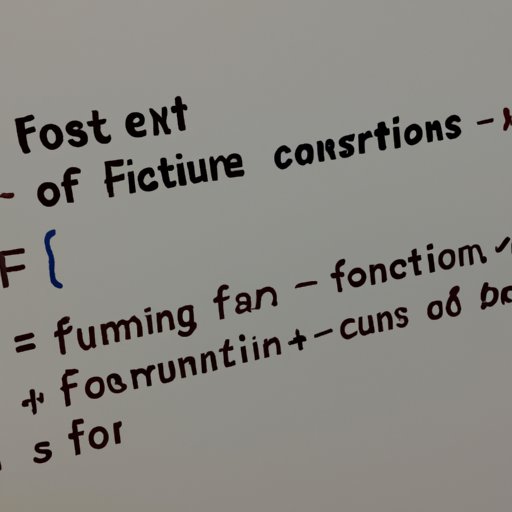Introduction
A function is an essential part of any programming language, and it is no different when it comes to computer science. Put simply, a function is a code block that performs a specific task. In other words, it is a set of instructions that tell a computer what to do. Functions are used to make programming more efficient and organized, allowing programmers to write code in a more logical way.
So, what are functions and how do they work in computer science? This article will explore the basics of functions and how they can be used in computer science.

Exploring the Basics of Functions in Computer Science
In order to understand the purpose and utility of functions in computer science, first it is important to understand what a function is. A function is a block of code that performs a specific task. It is like a mini-program within a program that takes some input and produces an output. The input can be data or parameters and the output can be a value or result.
The primary purpose of a function is to make programming more efficient and organized. By breaking down a program into smaller parts, each part can be written and tested individually. This makes debugging easier and allows for better code reuse.
When it comes to computer science, there are various types of functions. Some of the most common include user-defined functions, library functions, built-in functions, recursive functions, and anonymous functions.
User-Defined Functions
User-defined functions are functions that are created by the programmer. They are typically used when the same logic or code needs to be used multiple times in a program. This type of function allows the programmer to define the logic once and then call the function whenever it is needed.
Library Functions
Library functions are functions that are already defined in a library. A library is a collection of pre-written code that can be used by the programmer. These functions are typically used for common tasks such as sorting or searching, and they can save the programmer time and effort.
Built-In Functions
Built-in functions are functions that are already defined in the programming language itself. These are usually basic operations such as arithmetic or logical operations. For example, in C++, the built-in function “abs” is used to calculate the absolute value of a number.
Recursive Functions
Recursive functions are functions that call themselves. These functions are used to solve problems that can be broken down into smaller subproblems. The function calls itself until it reaches a base case, which is a situation where the problem can be solved without further recursion.
Anonymous Functions
Anonymous functions are functions that do not have a name. They are typically used as arguments to other functions or as inline functions in a single expression. In JavaScript, for example, anonymous functions are commonly used with the “map” and “filter” methods.
Writing Your Own Functions in Computer Science
Once you understand the basics of functions in computer science, you can start writing your own. The first step is to plan your function. Think about what the function should do, what inputs and outputs it should have, and how it should be structured. Once you have a plan, you can start writing the code.
Next, you need to define the inputs and outputs for your function. The inputs are the data or parameters that are passed into the function and the outputs are the values or results that are returned from the function. Make sure to clearly define what type of data each input and output should be.
Finally, you need to utilize variables. Variables are used to store data temporarily while the function is running. They allow you to pass data between different parts of the function and keep track of the current state of the function. When defining variables, make sure to give them descriptive names that indicate what type of data they contain.
Conclusion
In conclusion, functions are an essential part of any programming language, and they are no different when it comes to computer science. Functions are used to make programming more efficient and organized, allowing programmers to break down a program into smaller parts. There are various types of functions, including user-defined functions, library functions, built-in functions, recursive functions, and anonymous functions.
Writing your own functions in computer science involves planning the function, defining the inputs and outputs, and utilizing variables. With practice, you can become proficient at writing your own functions and reap the benefits of using them in computer science.
(Note: Is this article not meeting your expectations? Do you have knowledge or insights to share? Unlock new opportunities and expand your reach by joining our authors team. Click Registration to join us and share your expertise with our readers.)
